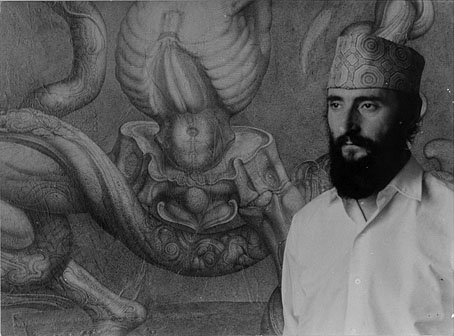
It was a surprise to see the death of Austrian artist Ernst Fuchs mentioned on the BBC website since I’d never seen him mentioned in the British media during his lifetime. Fuchs was one of those artists who would have been a natural Surrealist if he’d been born a few years earlier, and his work does occasionally receive a mention in the more comprehensive guides to Surrealism. The first place I saw any of his paintings was in the pages of Omni magazine when it was launched in the late 1970s. As well as providing a high-profile showcase to science-fiction writers, Omni in its early days avoided generic SF art in favour of the living practitioners of Fantastic Realism: Fuchs, HR Giger, Mati Klarwein, Robert Venosa, Rudolf Hausner, De Es Schwertberger and many others. Fuchs was often seen as the figurehead of this loose movement as a result of founding the Vienna School of Fantastic Realism in the 1940s, but Fantastic Realism as it’s generally applied is an umbrella term used to connect a generation of artists who were using hyper-real techniques to explore their obsessions. Fuchs’ obsessions often concern spirituality of one kind or another but he could be erotic as well, something you can’t always say about his many imitators in the current Visionary Art world. At his best his paintings seem caught midway between the Max Ernst style of the late 40s and Gustave Moreau’s more hieratic moments, with human figures or inhuman creatures emerging from (or melting into) mineral forms.
• Official site
• Fuchs at Wikiart
• Fuchs pages at Fantastic Visions
• 360-degree panorama of the Apocalypse Chapel, Klagenfurt
Battle of the Gods that have been Transformed (1952).
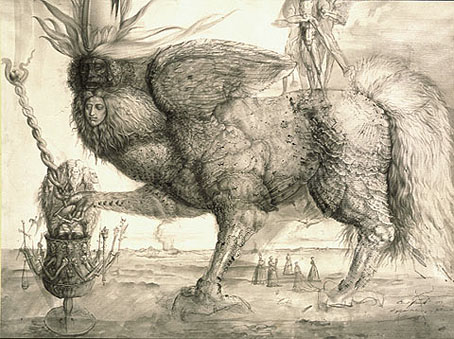
The Spirit of Mercury (1954).
The Anti-Laocoön (1965).
Cherub with an Amethyst (1969).
The Island of Aphrodite Before the Wall of Heaven (1974).
Elsewhere on { feuilleton }
• The fantastic art archive

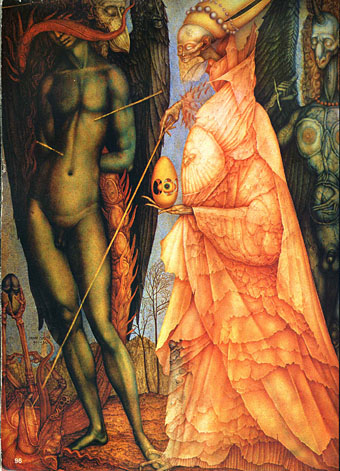
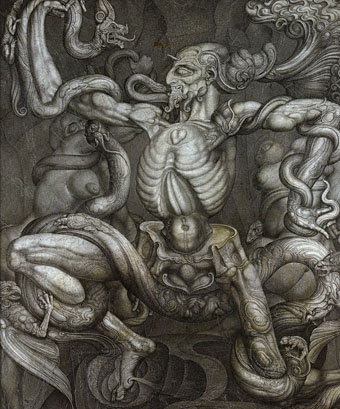
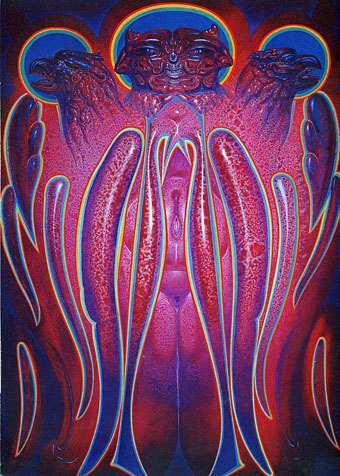
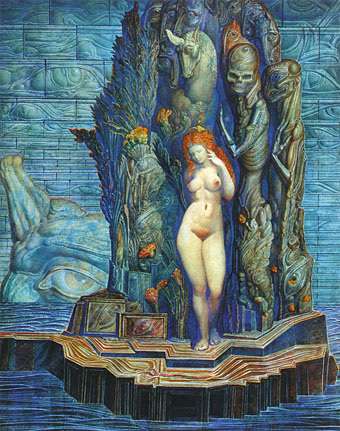
Sad news. It annoys me that it’s still impossible to get a decent book about Fuchs for a reasonable price in the UK. The definitive(?) study by Marcel Brion was a few hundred pounds on eBay last time I checked and I’m not holding my breath for a reprint.
Yes, I’ve tried searching for a decent Fuchs book on a number of occasions. Giger aside, it’s the same with most of the artists mentioned above, they’ve been outside the Anglophone art establishment for so long that no one would consider a book of their work. The last time you would have got anything would have been the late 70s when artists such as these could still be sold via the hangover from the psychedelic period.
Comini included one of his works in that “Fantastic Art of Vienna” book that Ballentine brought out in, let’s see, 1978.
I was very sorry and saddened to read about the death of Ernst Fuchs. As an art student in the late 1960’s and early 70’s I worshipped the man. I corresponded with him over the years and met him when he had his show at Aberbach gallery here in NY in 1974.
He was tall and very thin with a full beard and his trade mark brimless nat. We spent the day together and he introduced me to Mati Klarwein who had his studio here and where his Alpha Temple was assembled. He also helped me sell a few of my drawings to his collector friends.
In person he had charisma and you were drawn to him. He was also very modest about the tremendous talent he possessed. Although his work is great in reproduction, in person they seem super human in there perfection and technique. The way Durer’s “Hare” and “Piece of Turf” seem uncanny.
I have many books and catalogues on his work. I made it my business to buy as many books and catalogs could find. However, I purchased them when there was very little interest in his work here in the US. Book dealers were probably glad some fool took them off their hands. I had him sign a few of them which I treasure.
One of my all-time favorite artists. He will be missed, but his work will continue to inspire.